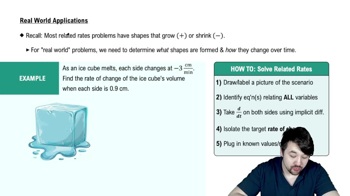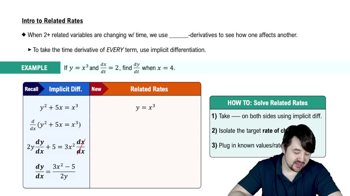Table of contents
- 0. Functions7h 52m
- Introduction to Functions16m
- Piecewise Functions10m
- Properties of Functions9m
- Common Functions1h 8m
- Transformations5m
- Combining Functions27m
- Exponent rules32m
- Exponential Functions28m
- Logarithmic Functions24m
- Properties of Logarithms34m
- Exponential & Logarithmic Equations35m
- Introduction to Trigonometric Functions38m
- Graphs of Trigonometric Functions44m
- Trigonometric Identities47m
- Inverse Trigonometric Functions48m
- 1. Limits and Continuity2h 2m
- 2. Intro to Derivatives1h 33m
- 3. Techniques of Differentiation3h 18m
- 4. Applications of Derivatives2h 38m
- 5. Graphical Applications of Derivatives6h 2m
- 6. Derivatives of Inverse, Exponential, & Logarithmic Functions2h 37m
- 7. Antiderivatives & Indefinite Integrals1h 26m
- 8. Definite Integrals3h 25m
4. Applications of Derivatives
Related Rates
Problem 3.R.115
Textbook Question
A jet flying at 450 mi/hr and traveling in a straight line at a constant elevation of 500 ft passes directly over a spectator at an air show. How quickly is the angle of elevation (between the ground and the line from the spectator to the jet) changing 2 seconds later?
 Verified step by step guidance
Verified step by step guidance1
Identify the relationship between the height of the jet, the distance it travels, and the angle of elevation. Use the tangent function: \( \tan(\theta) = \frac{h}{d} \), where \( h \) is the height (500 ft) and \( d \) is the horizontal distance from the spectator to the jet.
Determine the horizontal distance traveled by the jet after 2 seconds. Since the jet is flying at 450 mi/hr, convert this speed to feet per second (1 mile = 5280 feet) and then multiply by 2 seconds to find \( d \).
Differentiate the tangent function with respect to time to find the relationship between the angle of elevation \( \theta \) and time. Use implicit differentiation: \( \sec^2(\theta) \frac{d\theta}{dt} = \frac{1}{d} \frac{dd}{dt} \).
Calculate \( \frac{dd}{dt} \), which is the speed of the jet in feet per second, and substitute the values of \( h \), \( d \), and \( \frac{dd}{dt} \) into the differentiated equation.
Solve for \( \frac{d\theta}{dt} \) to find how quickly the angle of elevation is changing at that moment.
Recommended similar problem, with video answer:
 Verified Solution
Verified SolutionThis video solution was recommended by our tutors as helpful for the problem above
Video duration:
10mPlay a video:
Was this helpful?
Related Videos
Related Practice






